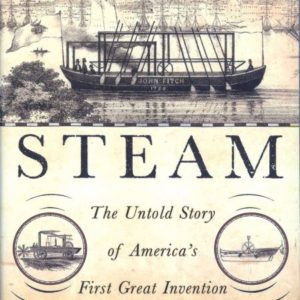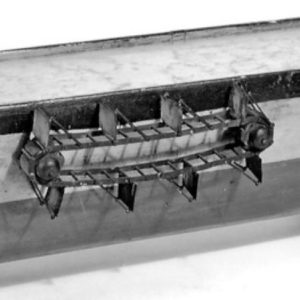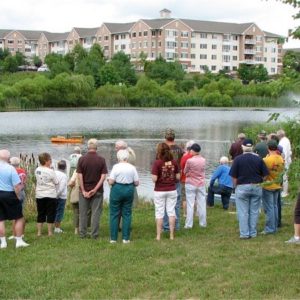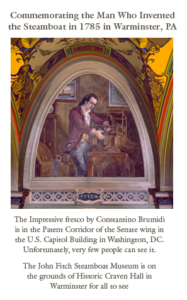The Adventuresome Life of John Fitch
The Adventuresome Life of John Fitch
John Fitch was born on a small farm near Hartford, Conn. in 1743. His father kept him out of school most of the time to work on the farm. In fact, John Fitch had less than two years of formal education in his entire life. Fortunately, he was “crazy for learning.” Fitch was an avid reader and excelled in mathematics.
To escape farm life, he became an apprentice to a clockmaker. But his master didn’t want to train a potential competitor, so Fitch was forced to do farm work until he was 21 and was released from his contract. It was an unhappy time.
Throughout his life, John Fitch was persistent. He was
determined to overcome any set back he might encounter.
But adversity was his nemesis.
Fitch wandered aimlessly until he settled in Trenton in 1767. There he became a prosperous silversmith in Trenton, New Jersey. Here is but one example of his fine craftsmanship on display in The Philadelphia History Museum (the former Atwater Kent Museum). Many have compared his skill as a silversmith with that of Paul Revere.
When the American Revolution started in 1775, Fitch joined the New Jersey militia as a gunsmith fitting bayonets onto muskets. But when the British occupied Trenton in 1776, Fitch lost everything. He fled to Warminster and eked out a living cleaning clocks. Then Fitch became a suttler or unauthorized provisioner, selling beer and tobacco to Washington’s troops in Valley Forge. But the colonial script he gathered was virtually worthless. He had lost out again.
Fitch needed another career. He heard that land in western Virginia could be surveyed and recorded, then sold with potentially huge profits. In 1780, he basically walked 700 miles from Warminster to what is now Bardstown, Ky. below Louisville. There he successfully surveyed and claimed 1,600 acres to sell to settlers as they came into the area. Fitch thought his future was financially secure. This was his 401(k) retirement plan. But it was not to be. Squatters eventually took over most of his land, leaving Fitch destitute yet again.
In 1782, Fitch walked to Pittsburgh. He planned to make big money by buying barrels of flour and selling them in New Orleans some 1,800 river miles away. Fitch joined a flotilla of flat boats and started to float down the Ohio River, but within four days, they were captured by Indians. Even though Cornwalis had surrendered in Yorktown the year before, the American Revolution dragged on. Fitch was turned over to the British in Detroit, and held prisoner near Montreal.
When released in late 1782, Fitch returned to Warminster and formed a land jobbing company. Over the next two years, Fitch and his team surveyed and claimed over 250,000 acres of the best land in Ohio. But the Land Ordinance of 1785 declared that such land had to be sold by Congress not by speculators like Fitch. He had lost everything and returned to Warminster utterly broke at the age of 42. Adversity had struck again, but Fitch was not a broken man.








Museum Template – Mad UX © 2018. All Rights Reserved

